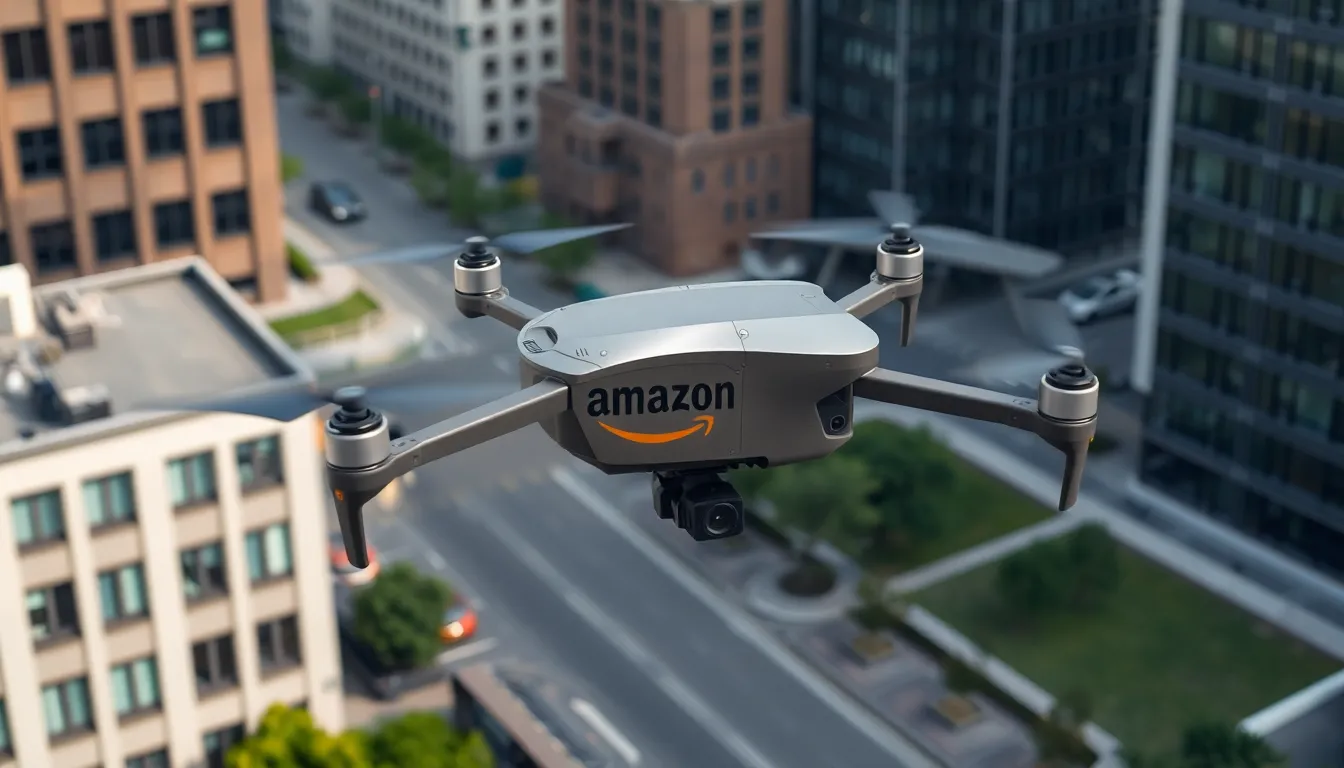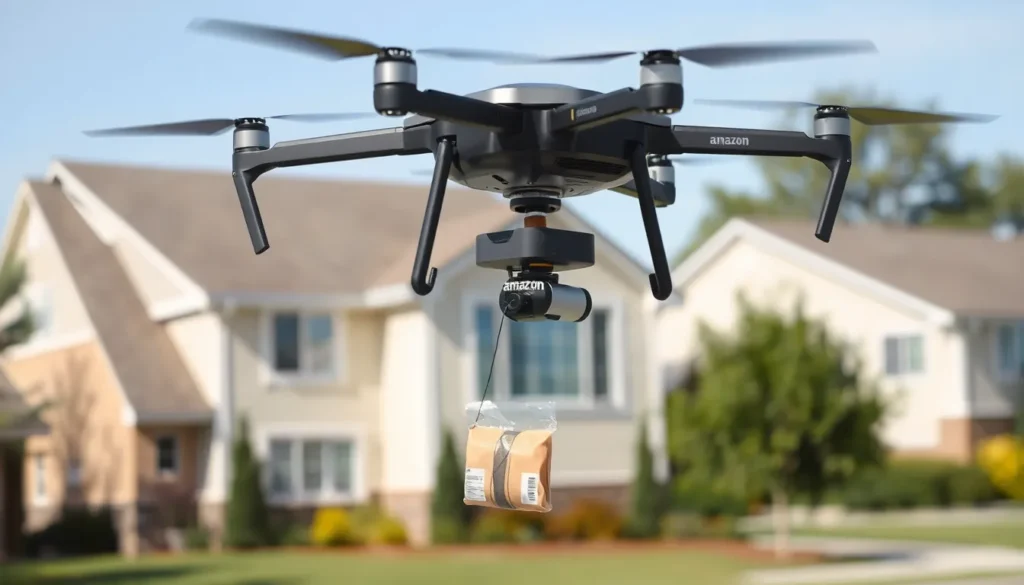Imagine a world where your online shopping habits don’t just involve waiting for a delivery truck but instead include a drone swooping down like a futuristic superhero. Amazon’s drone delivery is not just a whimsical idea; it’s quickly becoming a reality. These flying wonders promise to drop off packages at your doorstep faster than you can say “two-day shipping.”
Gone are the days of peering out the window, anxiously waiting for that delivery van. Now, you might just find your favorite gadget or snack gliding in from above. With advancements in technology and a sprinkle of Amazon magic, the future of shopping is taking flight, and it’s about to get a lot more exciting. Buckle up as we dive into the world of Amazon drones and discover how they’re reshaping the way we think about delivery.
Table of Contents
ToggleOverview of Amazon Drones Delivery
Amazon’s drone delivery service aims to enhance the speed and efficiency of package deliveries. Drones designed for this purpose can transport items directly to consumers within 30 minutes of ordering. These aerial vehicles utilize advanced navigation systems for safe and precise deliveries.
An extensive test program, conducted in various locations, showcases the drones navigating complex environments while adhering to safety regulations. Drones possess the capability to deliver small packages weighing up to five pounds, which covers a significant portion of Amazon’s offerings.
Customer reaction has generally been positive, with many expressing excitement over reduced delivery times. Additionally, the convenience of drone delivery aligns with the growing demand for quick services in e-commerce.
The environmental impact of drone delivery also contributes to its appeal. They operate with electric power, making them a greener alternative to traditional delivery vehicles. As Amazon expands its drone fleet, scalability remains a focus, ensuring the service can meet increasing customer demands.
Regulatory approval marks a critical component in launching this delivery method. Collaborations with aviation authorities enhance compliance and safety standards, paving the way for widespread adoption. Establishing landing zones in urban areas and residential neighborhoods ensures a seamless delivery process, minimizing disruptions to daily life.
Amazon continuously invests in research and development to improve drone technology. Innovations include better battery life and enhanced imaging systems to support efficient operations. Engaging customers with advancements in delivery options underscores Amazon’s commitment to enhancing the shopping experience.
Technology Behind Amazon Drones

Amazon’s drone delivery technology integrates advanced engineering and software capabilities to maximize efficiency. Innovations in drone design prioritize speed, safety, and reliability, ensuring packages reach customers promptly.
Drone Design and Features
Drones utilize lightweight materials to enhance flight performance. Each design incorporates multiple rotors for improved stability and maneuverability. Cameras and sensors support obstacle detection, allowing for safer navigation in urban environments. Capable of carrying packages weighing up to five pounds, these drones deliver a variety of items, from groceries to electronics. Electric motors power the drones, underscoring an emphasis on sustainability through reduced carbon emissions.
Navigation and Delivery Systems
Navigation systems rely on GPS and computer vision technology for accurate positioning. These systems map complex urban landscapes, enabling drones to adjust routes in real time. Algorithms optimize delivery paths, ensuring efficiency while maintaining safety protocols. Drones autonomously identify landing zones, minimizing disruptions during delivery. Coordination with air traffic control enhances regulatory compliance, ensuring safe flights across densely populated areas.
Benefits of Amazon Drones Delivery
Amazon’s drone delivery service offers significant advantages that cater to modern consumer demands. This innovative approach transforms how packages reach customers, emphasizing speed and environmental benefits.
Speed and Efficiency
Drones achieve remarkable delivery times, often completing routes within 30 minutes of placing an order. This swift service appeals to customers seeking immediate gratification. Advanced navigation systems enhance the accuracy of each delivery. Customers can expect reliable service as drones autonomously identify optimal paths. Flexibility reveals itself through the ability to navigate complex urban environments seamlessly. The efficiency of this system reduces congestion on roads, making deliveries smoother and quicker.
Environmental Impact
Electric-powered drones represent a greener alternative to traditional delivery vehicles. Reduced emissions from drone operations contribute positively to ecological sustainability. These drones operate quietly, minimizing noise pollution in residential areas. Utilizing lightweight materials enhances energy efficiency while maintaining stability. Their operational design focuses on lowering the carbon footprint of package delivery. Reduced traffic congestion from drone deliveries leads to fewer vehicles on the road, easing environmental stress. Amazon’s commitment to sustainability aligns with growing consumer preferences for eco-friendly services.
Challenges Facing Amazon Drones Delivery
Amazon’s drone delivery service encounters a variety of challenges that could impact its implementation and success.
Regulatory Hurdles
Regulatory compliance presents a significant barrier to the widespread adoption of drone delivery. Various regional and national aviation authorities impose strict regulations on drone operations. Operators must secure approvals for flight paths and operational areas to ensure safety. Compliance with these regulations requires coordination with air traffic management systems. Delays in regulatory processes can hinder Amazon’s ability to expand its service. Ongoing discussions with the FAA and other agencies are crucial for moving forward. Meeting these regulatory requirements often factors into the timeline for launching the service in new locations. Continuous engagement with policymakers remains essential to adapt to evolving regulations in the drone industry.
Safety Concerns
Safety is paramount when deploying drones in urban areas. Equipment failures and accidents could jeopardize public safety and damage property. Drones must incorporate robust safety features to mitigate these risks. Prospective technology improvements are needed to enhance obstacle avoidance and emergency landing capabilities. Community concerns about noise pollution also arise with increased drone traffic. Clarity on how drones operate and interact with other air traffic is vital for public acceptance. Additionally, addressing cybersecurity risks ensures that drone networks remain protected from malicious attacks. Ongoing safety assessments must guide operational practices to reassure customers and regulators alike.
Future of Amazon Drones Delivery
Amazon’s drone delivery service is set to transform e-commerce further. Research and development efforts will focus on enhancing drone capabilities, resulting in improved battery life and sophisticated imaging systems. Integrating artificial intelligence into navigation will lead to smarter delivery routes.
Safety innovations will become vital as the service expands. Drones must meet rigorous safety standards, with features that prevent equipment failures and accidents. Community concerns regarding noise and airspace congestion demand attention and mitigation.
Scalability strategies are essential for reaching broader areas. Establishing landing zones in urban settings allows for seamless integration into existing delivery networks. Coordination with local governments will play a significant role in determining suitable operational areas.
In addressing environmental impact, drone technology will contribute significantly to sustainability goals. This transportation method offers a reduction in emissions and noise pollution compared to traditional vehicles. The lightweight designs improve energy efficiency, aligning with customers’ growing preference for eco-friendly options.
Amazon’s achievements thus far demonstrate promising potential. The ability to deliver packages in under 30 minutes appeals to consumer expectations in a fast-paced marketplace. Positive customer reactions indicate strong support for this innovative service, reinforcing its anticipated impact on future shopping experiences.
Collaborations with aviation authorities remain crucial. Gaining regulatory approval will help navigate the complex legal landscape surrounding drone operations. Efforts to engage with policymakers will ensure ongoing compliance with evolving regulations, fostering public trust and acceptance of the drone delivery model.
Amazon’s drone delivery service is poised to reshape the e-commerce landscape by enhancing speed and efficiency. The combination of advanced technology and commitment to sustainability positions these drones as a viable solution for modern delivery challenges. As the service continues to develop and expand, it promises to meet the growing consumer demand for quick and eco-friendly delivery options.
While challenges remain in regulatory compliance and safety, ongoing innovations and partnerships with aviation authorities will be crucial for success. The excitement surrounding this service reflects a broader shift towards more convenient shopping experiences. With its focus on improving delivery times and reducing environmental impact, Amazon is paving the way for a future where drone delivery becomes a standard aspect of online shopping.

